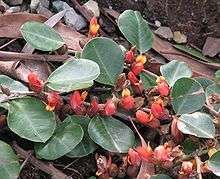Gastrolobium minus
| broad-leaved brachysema | |
|---|---|
 | |
| Scientific classification | |
| Kingdom: | Plantae |
| (unranked): | Angiosperms |
| (unranked): | Eudicots |
| (unranked): | Rosids |
| Order: | Fabales |
| Family: | Fabaceae |
| Genus: | Gastrolobium |
| Species: | G. minus |
| Binomial name | |
| Gastrolobium minus (Crisp) G.Chandler & Crisp | |
| Synonyms | |
|
Brachysema latifolium Hort. | |
Gastrolobium minus, also known as broad-leaved brachysema,[1] is a prostrate shrub which is endemic to the south-west of Western Australia. It is a member of the family Fabaceae and of the genus Gastrolobium, which contains many toxic species, however the toxicity of this species is unknown.[2]
Description
The plant grows to about 1 metre in diameter and has leaves that are oval in shape with a dark green upper surface and a silky undersurface.[1] The flowers appear predominantly between July and October in the species native range. These are orange-red[1] with a standard that has recurved margins and yellow markings[2]
Distribution and habitat
The species occurs in open Jarrah (Eucalyptus marginata) forest near Mount Barker and Cranbrook, with an outlying population in Fitzgerald River National Park.[2]
Cultivation
The species has been popular in cultivation for many years, often distributed under the incorrect name of Brachysema latifolium.[3] The plant may be used as a groundcover on embankments or in large containers or hanging baskets.[1] It prefers light shade and good drainage, and is somewhat frost-tolerant.[1]
References
- 1 2 3 4 5 Greig, D. (1987). The Australian Gardener’s Wildflower Catalogue. Australia: Angus & Robertson. ISBN 0-207-15460-0.
- 1 2 3 Chandler, G. T., M.D. Crisp, L.W. Cayzer, and R.J. Bayer. (2002). "Monograph of Gastrolobium (Fabaceae: Mirbelieae)" (PDF). Australian Systematic Botany. 15 (5): 619–739. doi:10.1071/SB01010.
- ↑ Wrigley J.W.; Fagg M. (1979). Australian Native Plants. William Collins Publishers Sydney, Australia. ISBN 0-00-216416-7.
External links
- "Gastrolobium minus". FloraBase. Western Australian Government Department of Parks and Wildlife.

- "Gastrolobium minus". Australian Plant Name Index (APNI), IBIS database. Centre for Plant Biodiversity Research, Australian Government.